My Garden Coat
words and photos by Sally Hands
As a committed spindle spinner for over 10 years, I thought the time had come to spin a really big project.
I usually use local fleece as I’m lucky enough to live in Wales where we have more sheep than people. I’m also a big fan of the Fibreshed movement and of saving the planet. I won’t use fibre with air miles on it; I buy local and grow my own dyes – woad and madder for blue and brick red and onion skins from the kitchen for yellow.
A couple of summers ago, I came back from a nearby farm (Cwmchwefru Wool) with a big Corriedale/ Shetland fleece, soaked it overnight, washed it in the morning with dish soap in very hot water, and then spun it in the machine in sections inside a pillowcase.
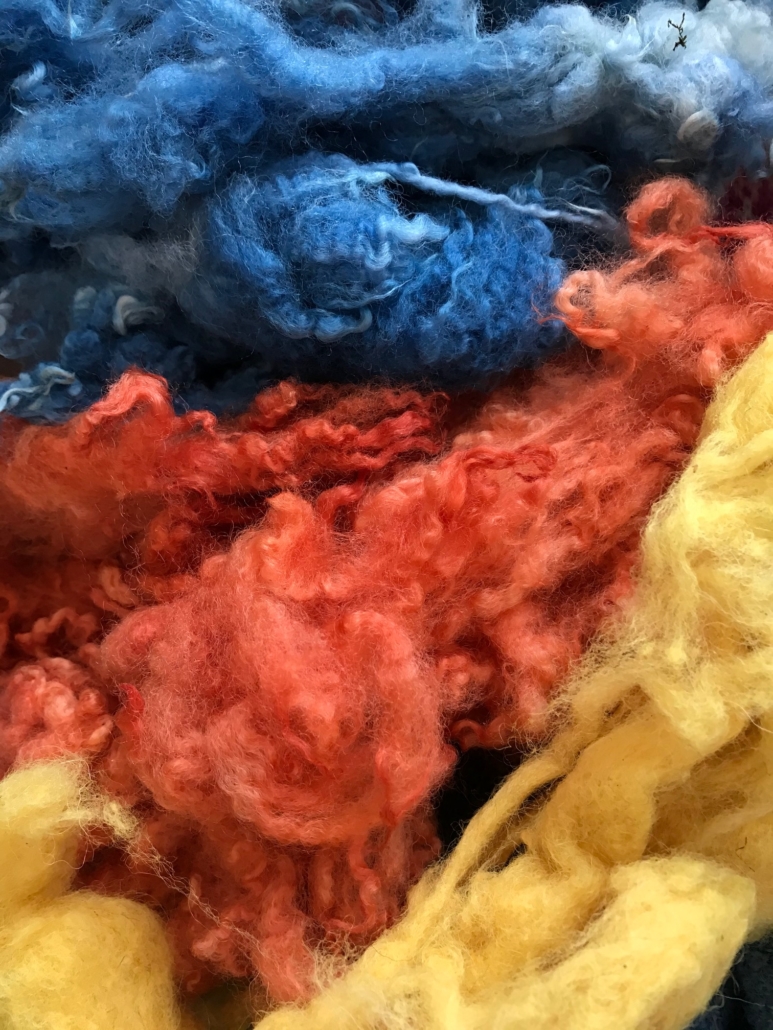
Over a period of weeks, I dyed it with the plant dyes from the garden. I had to source some woad from a supplier as I didn’t have enough fresh stuff. I ended up with a big pile of multicoloured fluff in different shades. The dyeing didn’t have to be consistent since I was going to blend and mix it.
It’s nice sometimes to make projects with minimal equipment in a small space. With a spindle, rigid heddle loom, and something to card or comb with, this was one of those projects. Even a relative beginner could make this, and if you weren’t a confident spindle spinner when you started, you would be when you finished! For a beginner, I’d recommend you prepare a smooth lump-free length of fibre; I comb mine and then blend it a bit, either by using a blending board or just by breaking off small pieces of coloured fluff and spinning them randomly. And it helps to pre-draft.
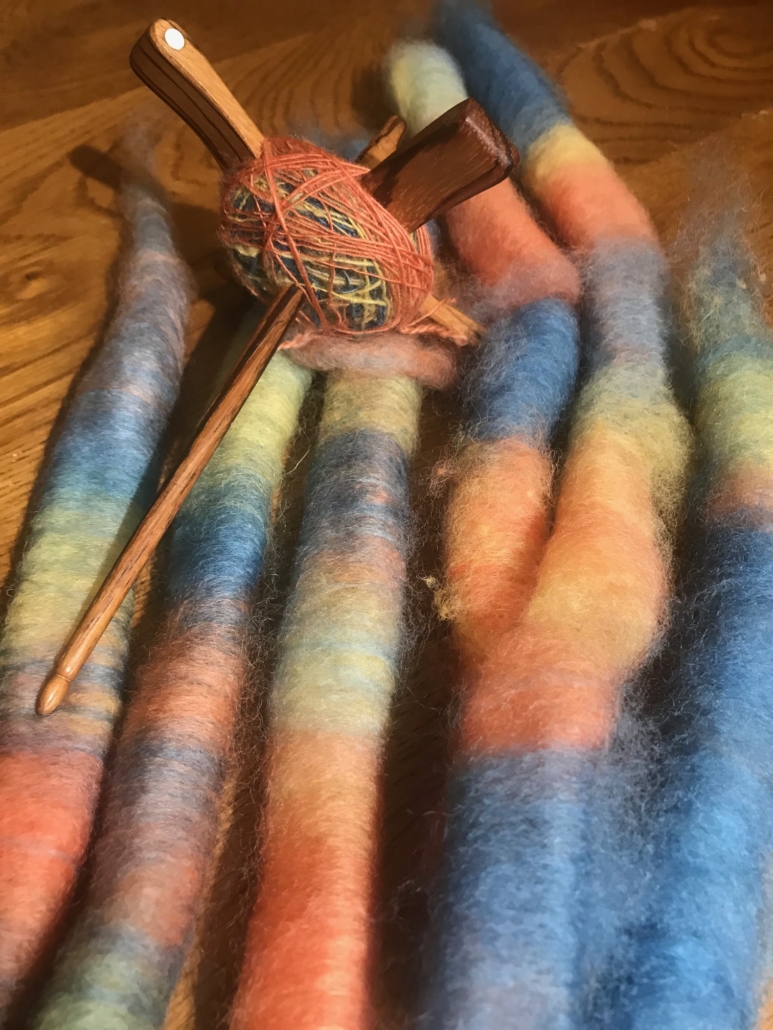
My favourite spindle is a Turkish spindle from Ian Tait at IST Craft on the Isle of Wight, and this spindle was great for all the singles. To make a 2 ply, I put 2 cops into 2 old teapots and plied from the spouts. This puts a useful tension on the yarn as you ply. I plied on the heavy low-whorl spindle I learned to spin on. I was using the same yarn for warp and weft and spun both the same way, but I did put a bit of extra twist in. You don’t want your yarn fraying in the beater as it’s woven. The singles were a lively multicoloured thread in blues, reds, and yellows, and I plied randomly.
This way of spinning is slow. With the Turkish spindle I have to watch my hands for the over-two under-one wind on. It could be quicker to use a light high whorl spindle with a faster spin and an easier wind on where you don’t have to look at your hands. But my Turkish spindle is a favourite, and this was a big project; I’d be spinning a little bit every day for nearly a year, so I used the spindle I loved. I work as an artist and musician and have come to realise it’s the process that is a joy more than the finished piece.
I almost always spin my default yarn. It’s quite fine: the singles are 32 WPI, and the 2 ply is 18 WPI. I spin a small cop as twirling a heavy spindle hurts due to an old shoulder injury. My 2-ply skein weighed about 32 grams when it was washed and measured around 90 yards. I looked at the first skein in these colours and thought it looked lovely. Only another 25 skeins to go!
When the pile of skeins grew to about 20, I just had to wind the warp. I couldn’t wait to see the colour effect. I wound a warp on the rigid heddle loom that was 28 inches wide. Since I was going to weave 120 inches, I added on top of that about 18 inches to the warp for waste. The warp in the random spun yarn looked yummy!
I quickly went on to spin the rest of the yarn and wove the weft to 120 inches. After cutting the fabric off the loom and admiring it, I zig-zagged with the sewing machine across the middle halfway up and cut across, giving me 2 rectangles measuring 28 inches x 60 inches. After being washed, it was a little smaller. I pressed it damp after again spinning it in the washing machine in a pillowcase to protect it and stitched it by hand into a loose cocoon coat.
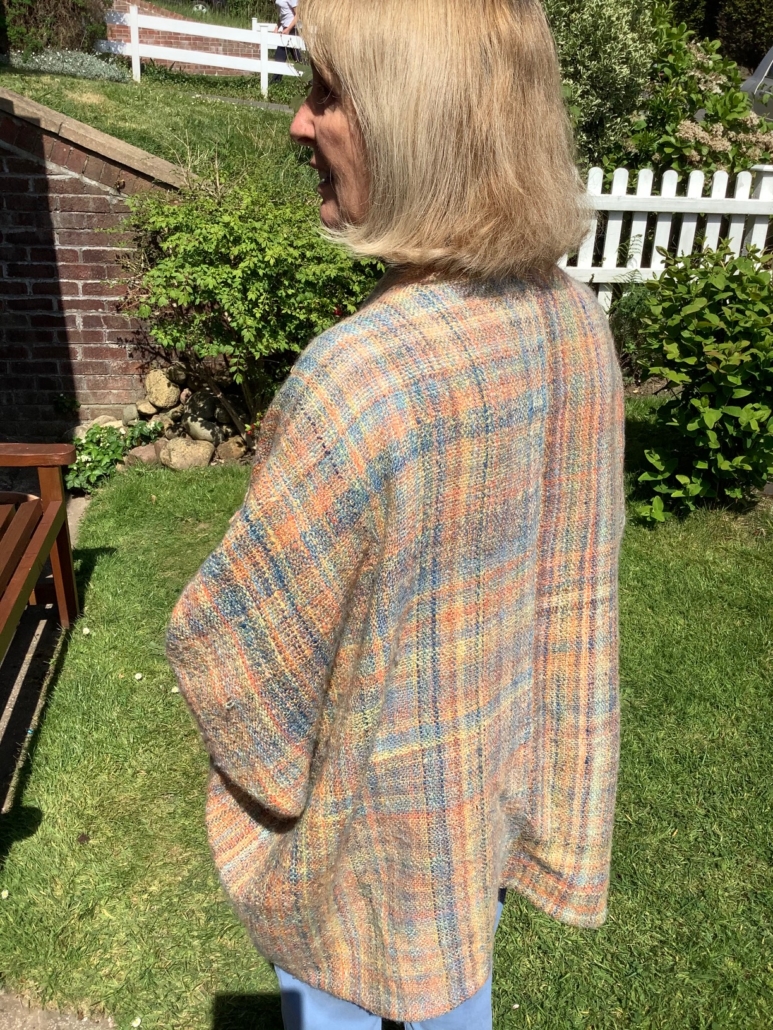
I’ve been so pleased with this simple coat. I’ve been asked where I bought it, and I’ve worn it to the opera. My yarn wove nicely in a 10-dent reed, but you can spin the yarn to any thickness; just warp it in a fatter reed if it’s thicker. I’ve seen loads of cocoon jackets and coats on Pinterest this year, and if you want to be environmentally friendly you can wear it over basic leggings and a t-shirt and look dressed up. You don’t have to shop for new clothes.
I’m considering my next big project and may buy black, fawn, and grey fleece from the farm and make a multicoloured yarn in natural sheep shades next time. Just don’t worry about quick projects; enjoy the spinning. It’s the process that satisfies the soul!
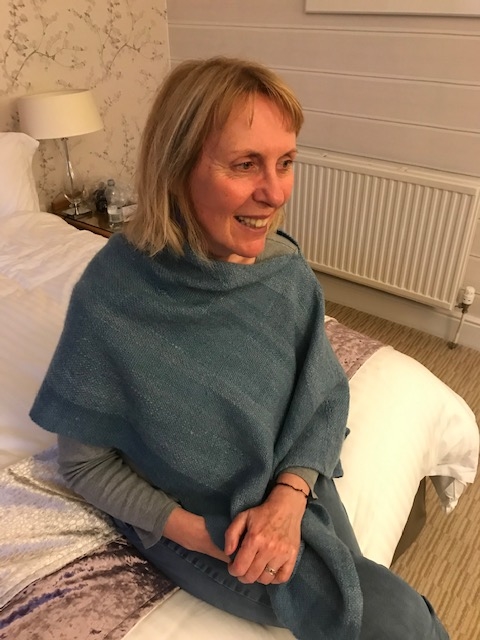
Sally Hands is an artist and musician working in Wales. She spends all day making and teaching art and music; at night she has acquired the bad habit of spindle spinning lying across an armchair with her feet in her husband’s lap demanding a foot massage. You can find her @sallyhands on Instagram.
PLY Magazine believes that Black lives matter, as well as LBGTQI+ lives. Those most vulnerable and persecuted in our communities deserve our love and support. Please be good to each other.


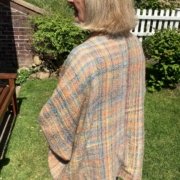


I would love to attempt to duplicate this project! I don’t understand the final construction of the coat. Could you link to the pattern you used, or a rough diagram of how the pieces connect?
Hi, I found this pattern in several old weaving books. The most recent was the Saori book- Self Innovation through Free Weaving by Misao Jo. They call it the Marguerite Style coat. They’ve actually made it wider in panels but the shape is the same. It’s a great pattern book for weavers if you get it!
I’ll also send you a diagram. Thanks!
http://pyweb.swan.ac.uk/~hands/GardenCoat.jpg
Garden coat- measured and diagram